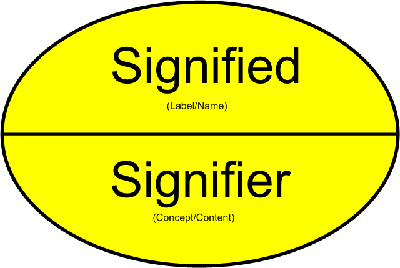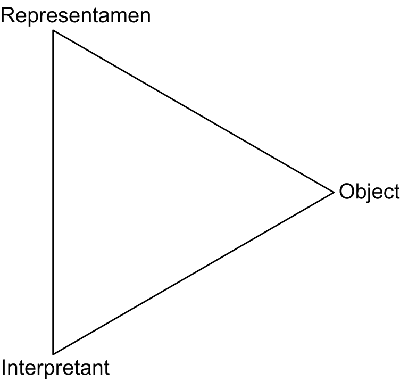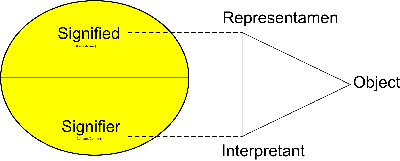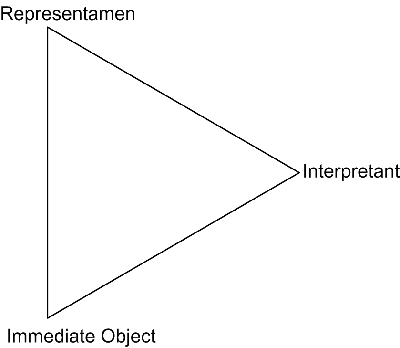Semiotics of Programming Part I
Posted on Fri 24 September 2010 in Rumination
I am reading a fascinating new book by Kumiko Tanaka-Ishii, The Semiotics of Programming published this year by Cambridge University Press. In the book Tanaka-Ishii analyzes the semantics of programming languages from the perspective of Saussurian and Peircian semiotics, that is, as systems of signs. In so doing, Tanaka-Ishii not only gives us a clearer picture of the semantics of programming languages, but gives us a critical analysis of key concepts in semiotic theory.
Although the topics covered in the book may appear somewhat distant from my immediate research concentration, it is hard to touch one part of philosophy (or mathematics, or computer science, or anthropology…) without touching every other part. Also, the topic is very interesting! My plan is to spread out my discussion of this book across several blog posts published intermittently.
Background
Semiotics is the study of signs, and systems of signs. An excellent background in semiotics can be found in the free online textbook Signs for Beginners by Daniel Chandlers.
There are two principal models of signs in modern semiotics, a triadic model due to Charles Peirce, and a dyadic model due to Ferdinand de Saussure.
Dyadic Model
In the dyadic model of signs, a sign consists of two parts, the signifier, and the signified. The signifier is the physical or mental token that carries meaning; it is the sign’s form, its name, or label. The signified is the concept or content associated with the sign. A common misunderstanding is that the signified corresponds to that which the sign refers. This is false. Instead, the signified corresponds to the notion associated with the sign. The written word CHAIR is a sign. It’s signifier is the string of characters C-H-A-I-R. Its signified is not a specific physical chair, or even a collection of chairs. Instead it is the concept of a chair. In Saussure’s dyadic model, a sign must have both a signifier and a signified, but the relationship between signifier and signified is (relatively) arbitrary, for each concept there may be more than one signifier, and the same signifier may signify more than one concept.
A sign does not have meaning in virtue of the signifier and signified alone, but attains value as being part of a system of signs and meaning through its interpretation. Saussure argued that concepts like that denoted by CHAIR are not defined positively, but in contrast with other signs in the system of signs in which it is part: “What characterizes each most exactly is being whatever the others are not” (Saussure 1983(As quoted in Chandler 1994)). This emphasis on oppositions between signs is a basis of structuralist thought in anthropology, sociology, and critical theory.

The notion that the content of a sign is defined negatively in this way may strike some as strange. Actually, this is not so unusual an approach in the information sciences where information is the difference that makes a difference, as Gregory Bateson famously remarked. For example, in a scheme of possible-world semantics for a logic language L, the content of a sentence s in L is defined in terms of the possible-worlds that that sentence excludes. In the information content measure developed by Rudolf Carnap and Yehoshua Bar-Hillel, the information content of a sentence, cont(s) = 1 – lp(s), where lp(s) is the logical probability of s. An alternative measure is inf(s)=-log ls(s) (Bremer and Cohnitz 2004). The basic motivation for these definitions is that the greater the logical probability of a sentence, the less information that sentence conveys, since such sentences exclude few or no possible worlds. A tautological sentence is true in every possible world, and so, conveys no information at all! And in Shannon’s Mathematical Communication Theory (information theory), the greater the probability of the signal being received, the less information it contains, relative to a scheme of probabilities of possible signals. Its the surprise value theory of information content*.
Triadic Model
Saussure’s dyadic model is not the only game in town. Charles Peirce developed a popular triadic model of the sign. The model is a triad consisting of the representamen, the interpretant, and the object.

The conventional interpretation of these is given in Daniel Chandler’s book as:
- The Representamen: the form which the sign takes (not necessarily material);
- An Interpretant: not an interpreter but rather the sense made of the sign;
- An Object: to which the sign refers.
'A sign... [in the form of a representamen] is something which stands to somebody for something in some respect or capacity. It addresses somebody, that is, creates in the mind of that person an equivalent sign, or perhaps a more developed sign. That sign which it creates I call the interpretant of the first sign. T
he sign stands for something, its object. It stands for that object, not in all respects, but in reference to a sort of idea, which I have sometimes called the ground of the representamen' (Peirce 1931-58, 2.228). The interaction between the representamen, the object and the interpretant is referred to by Peirce as 'semiosis' (ibid., 5.484). Within Peirce's model of the sign, the traffic light sign for 'stop' would consist of: a red light facing traffic at an intersection (the representamen); vehicles halting (the object) and the idea that a red light indicates that vehicles must stop (the interpretant). (http://www.aber.ac.uk/media/Documents/S4B/sem02.html)
Next, we will look at the conventional understanding of the relationship between these two models of signs. Kumiko Tanaka-Ishii rejects this in favor of an alternative interpretation she offers, and then attempts to demonstrate in the context of signs within in computer programs.
Conventional Understanding of the Relationship Between Saussurian and Peircian Sign Models
The conventional wisdom is that Saussure’s signifier corresponds to Peirce’s representamen and Saussure’s signified corresponds to Peirce’s interpretant. Peirce’s object is generally considered to be the referent (object) to which the sign refers, and is thus absent from Saussure’s model. Figure 3 depicts the conventionally understood relationship between these models.

Tanaka-Ishii prefers an alternate interpretation of Peirce’s sign model, and thus advocates a different relationship between the dyadic and triadic sign models. Tanaka-Ishii notes that for Peirce the sign stands for an aspect of an object, but only in reference to a concept (p. 30), “The Sign stands for something, its object. It stands for that object, not in all respects but in reference to a sort of idea.” Tanaka-Ishii recalls Peirce’s distinction between immediate and dynamical objects, with the former being the object as represented by the sign, and the latter the object outside of the sign (p. 31). Tanaka-Ishii concludes that Peirce’s object in the sign model is the immediate object. But if both the object and the interpretant are conceptual or mental, the conventional correspondence between interpretant and signified may be reconsidered. According to Tanaka-Ishii, the role of the interpretant in semiosis, the production of signs, holds the clue. Locating semiosis in Saussure’s model as use within a system of signs, wherein the value of a sign arises out of a system of differences, Tanaka-Ishii realigns Peirce’s sign model as follows:

Hence, Tanaka-Ishii argues that the most correct correspondence between sign models has the following correspondences. Saussure’s signifier corresponds to Peirce’s representamen, as before. Saussure’s signified corresponds to Peirce’s immediate object. Peirce’s interpretant is external to Saussure’s sign model but appears as use within a system of signs. This realignment is depicted in Figure 5. Its immediate consequence is that these two models are taken to be essentially compatible.

Conclusions
If Tanaka-Ishii were only interested in articulating just what Peirce and Saussure meant by each component of their sign model, this would be, in my opinion, a fairly uninteresting exercise, a kind of historical curiosity of interest to only a few. I am, as a rule, more interested in the utility and correctness of ideas than in honoring our scholarly predecessors as intellectual gurus or in slavishly delineating the genealogy of their ideas. Moreover, the evidence brought to bear on her reinterpretation of Peirce and Saussure is not especially robust. I doubt that it will convince many semioticians, all on its own.
However, Tanaka-Ishii immediately puts this exercise to work by applying it to a series of fairly convincing (and illuminating) analyses within the context of programming and computation. For some within the humanities and social sciences, an application of semiotics to the formal domain of programming may be somewhat surprising, especially given that Tanaka-Ishii does not locate signs only within the domain of human interpretation and interaction. But such an analysis has immediate merit. The semantics and syntax of programming languages are very well understood (and obviously have mechanically implemented interpreters) and are highly regular. The kinds of complexities inherent in natural language do not, for the most part, intrude. Therefore it might provide a well grounded basis for a theory of signs that might inform our analyses of the much more complicated sign systems of natural language and culture. It might even suggest a new programming paradigm itself.
In the next post in this series, we will take a look at Tanaka-Ishii’s semiotic analysis of the functional and object-oriented programming paradigms within the context of her rearrangement of dyadic and triadic semiotics described above.
*Still, it is not clear at what scale or in what aspect such differences make a difference, and I do not know how seriously semioticians take the embodiment of signs in the material world.
REFERENCES
Bremer, Manuel and Daniel Cohnitiz. Information and information flow: An introduction. Linguistics and Philosophy. Vol. 3. ed. Gunther Grewendorf, Wolfram Hinzen, Hans Kamp, and Helmut Weiss. ontos verlag. Frankfurt, Germany. 2004.
Chandler, Daniel. Semiotics for beginners URL (09/23/2010.) http://www.aber.ac.uk/media/Documents/S4B/semiotic.html 1994.
Saussure, Ferdinand de. Course in general linguistics. Translated by Roy Harris. London: Duckworth. ([1916] 1983).
Tanaka-Ishii, Kumiko. Semiotics of programming. Cambridge University Press, New York, NY. 2010.